Sarah Salih • King’s College London
Recommended citation: Sarah Salih, “The Trouble with ‘Female Sexuality,’” Different Visions: New Perspectives on Medieval Art 5 (2014). https://doi.org/10.61302/IRRS2726.
Using medieval western art to speak of female sexuality is difficult. Karma Lochrie argues that medieval women’s sexuality was organised in ways so alien to current categories that it requires careful excavation:
Medieval hybrids that are incomprehensible today, such as ‘chaste marriage’ or even a kind of ‘willful virginity,’ were not only practised during the Middle Ages, but they suggest a much more diffused and complex interaction of categories than we are used to. Armed only with the heterosexual/homosexual divide and a presumption of heteronormativity, we cannot even begin to sort out such categories as Amazons, female masculinity, or even virginity.[1]
Lochrie’s book, like most studies of medieval sexuality, is primarily concerned with textual sources. Can the visual arts contribute to this work of categorisation? This brief overview will suggest that such a focus tends if anything to find more uncertainties of various kinds; to indicate that “Female sexuality [in the visual arts] … wasn’t.” The encounters of women, the visual arts and eros, that is, are so heterogenous and their boundaries so unclear as to make the category elusive. Of course women in the Middle Ages had sexual experiences, desires, fantasies, pleasures and pains; and of course we cannot have direct access to the experiences of the long dead, though we can converse about them. But the very nature of artistic representation, whether visual or textual, means that such desires and pleasures become shared property, which cannot be said to belong to women more than to men – or indeed to the medieval rather than to the modern. Hans Belting argues that “The human being is the natural locus of images, a living organ for images”; thus a contemporary viewer, assessing the sexual content or impact of a medieval image, must put their own bodies and sensibilities forward as substitutes for those of medieval viewers.[2]
“Sexuality” itself, of course, is a post-medieval term, which is nevertheless, with appropriate caveats, regularly used. I do not propose not using it, but would note to begin with that it seems unlikely that its range quite matches any medieval domain of knowledge. Medieval textual sources tell us a number of quite different things about female sexuality: that a woman’s desire may be directed to men, women, herself, or lifeless things; that women have an insatiable desire to be penetrated; that they are naturally inclined towards chastity; that their reluctance can be overcome by violence or seduction.[3] Visual sources are no more consistent. I might identify both a painting of St. Catherine of Siena’s stigmatisation by a crucifix (fig. 1) and a female exhibitionist figure (fig. 2) as illustrating aspects of female sexuality, but there is no evidence that these images spoke to one another in any known medieval context: their conjunction is a product of my framing category. The split between sacred and profane desires is so pronounced that the category does not cohere.
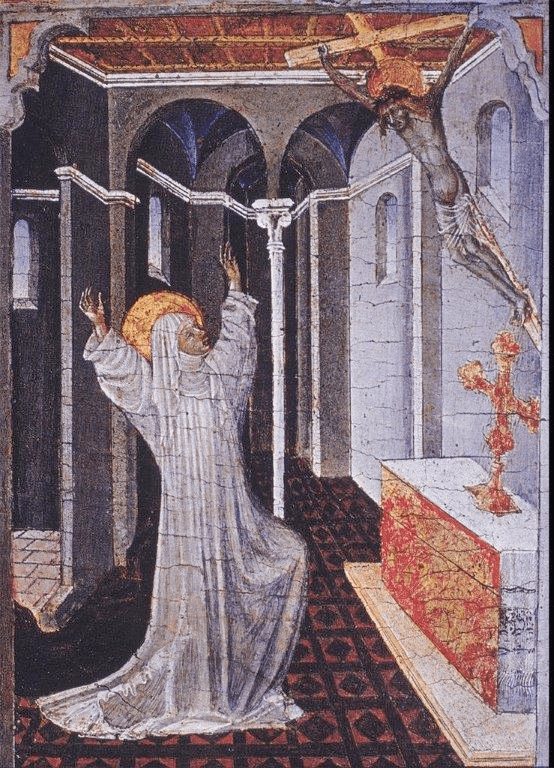
Fig. 1. Giovanni di Paolo, Stigmatization of St Catherine of Siena, tempera and gold on wood, 1460–1465. New York, Metropolitan Museum of Art, inv. no. 1997.117.3. (Met open use policy via ArtStor)
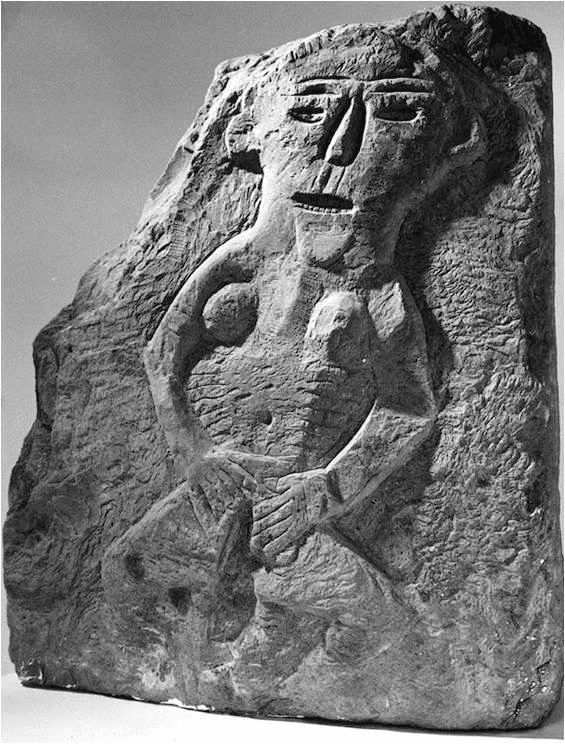
Fig. 2. Female exhibitionist figure, stone, date unknown, Old Parish Church, Llandrindod Wells. Llandrindod Wells, Radnorshire Museum (Photo: John Harding)
The problem of sexual identities is not quite, as it is sometimes put, that the Middle Ages preceded them. Lochrie argues persuasively that the absence of a homosexual identity means that the presumption of a heteronormative framework must be questioned.[4] But the contemporary division of homo and heterosexualities is not the only way to map desires. Medieval women did not lack sexual identities (although men’s are harder to pin down): as maidens, wives, professed virgins and whores their presumed sexual activity was the foundational category that determined their dress, demeanour, social position and material location. Thanks to the work of social historians on women’s lifecycles, we know quite a lot about these identities, their local variations and their slippages. These sexual identity categories, however, do not necessarily tell us about women’s sexual pleasures, pains and desires, or the extent to which they felt at one with or alienated from such identity categories. The Book of Margery Kempe shows its protagonist at various periods of her life as a sexually satisfied young wife, who had “ful many delectabyl thowtys, fleschly lustys, and inordinate lovys” of her husband’s body, as a wife later repulsed from marital sex as from “the mukke in the chanel,” and as the Bride of a Christ who claims the right of a husband to “be homly wyth the and lyn in thi bed wyth the.”[5] But Kempe’s book, despite its seeming frankness, is not a transparent witness but a crafted tale of a penitent sinner; meanwhile other desires, such as female homoeroticism, hardly break discursive cover at all.[6]
The topic of “female sexuality in medieval art” includes two overlapping fields of activity: women as sexualised addressees and consumers of art, and the sexualised representation of women in art. Both raise so many problems of identification and interpretation that further examination shows them to be almost nothing but problems.
It might seem more promising to begin with female sexual subjects; that is, female spectators of sexualised art, since, as Sherry Lindquist shows in this volume, it is well-known that devout women had intense affective responses to artefacts such as crucifixes. The phenomenon of ‘sex without sex’ between chaste people might be mediated through visual art.[7] The image of St. Catherine mentioned above depicts one of the most famous of such events, showing the saint’s ardor as she opens her arms to receive the stigmata from the crucifix. However, I would caution that art cannot be isolated from other triggers, that sexuality in such responses cannot be isolated from other drives and affects, and that women’s responses cannot be isolated from men’s; indeed, that the shared ground of devotional eros tends to break down gender difference. For the anchoritic reader of “The Wooing of Our Lord,” the crucifix is the site of union. The text directs her to speak to Christ in these words:
My body hangs with your body nailed to the cross, enclosed on all sides within four walls, and I will hang with you and never again come off my cross until I die. For then I shall leap from the cross to rest, from sorrow to joy and to eternal bliss. Oh Jesus, it is so sweet to hang with you, for when I see you hanging beside me, your great sweetness totally frees me from pain.[8]
While she spoke, she would surely fix her eyes on the crucifix in her cell and incorporate that into this fulfilment of her union with Christ: the artefact would be inextricably linked with the height of her pleasure. It is not, however, the sole cause of it: this is a multi-media experience, combining words, the artefact, visionary capacity, and probably movement, all of which are necessary constituents of the pleasure. If it is complexly visual, it is also complexly erotic. To describe such practices either as channelling sexual response into devotional purposes, or as smuggling sexuality under cover of devotion, is to overclarify. The practice is designed to produce sexual and devotional emotions together, and which was experienced as the primary response would have varied from viewer to viewer, from moment to moment.
Gender, however, was not a significant factor in this variability; all the available evidence suggests that women’s response to devotional art was not markedly different from men’s. Men were if anything more often interpellated as passionate spectators of crucifixes; Rupert of Deutz’s often-cited account of the passionate kiss of a crucifix figure is one of many such encounters.[9] The illustrations of the Rothschild Canticles are some of the most joyous images of mystical eros, as the figure of the Bride cavorts with a unicorn (fol. 51r; fig. 3), or reaches up to her Heavenly Bridegroom (fol. 66r; fig. 4). Jeffrey Hamburger’s extensive study of the manuscript sites it in the context of feminine spirituality, arguing “[t]hat the Rothschild Canticles was intended for a woman is virtually certain.”[10] Nevertheless, as Sarah Bromberg points out, the manuscript also includes images of men as lovers of Christ, and male readers would not have been excluded from identification with the Bride: “[a] male viewer of the Rothschild Canticles might be . . . accustomed to using the visually feminized symbol of the Sponsa in order to act out his own supplication in seeking divine union.”[11] If the position of the Bride is that of female sexuality, then it is not restricted to women.
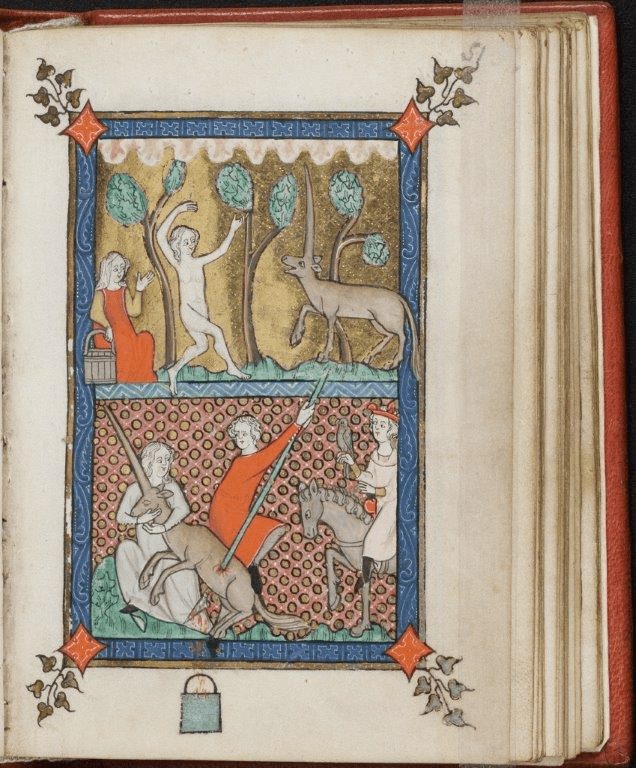
Fig. 3. Bride and unicorn, Rothschild Canticles, Rhineland, c. 1300. New Haven, Yale Beinecke Rare Book and Manuscript Library, MS 404, fol. 51r (Beinecke Rare Book & Manuscript Library: fair use policy)
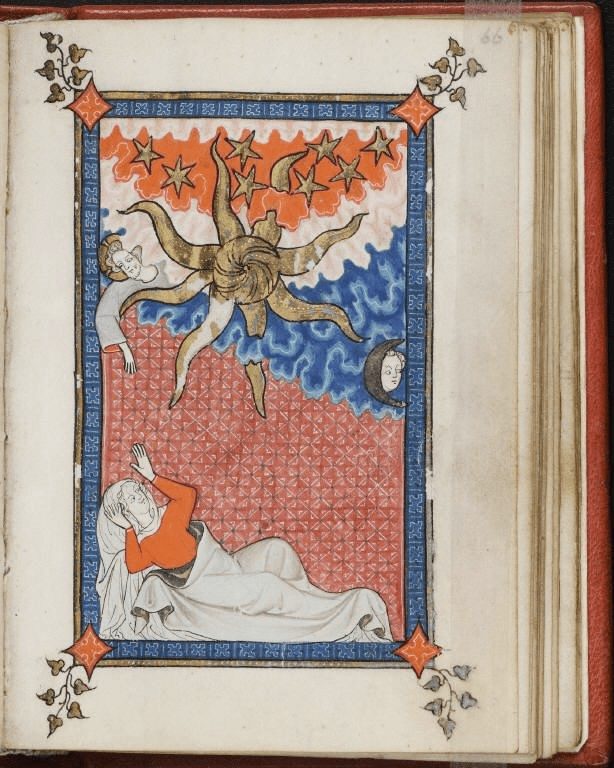
Fig. 4. Spiritual marriage, Rothschild Canticles, Rhineland, c. 1300. New Haven, Yale Beinecke Rare Book and Manuscript Library, MS 404, fol. 66r (Beinecke Rare Book & Manuscript Library: fair use policy)
Such positions are formed in networks of persons, places and material objects.[12] The anchoress contemplating the crucifix in “The Wooing of our Lord” speaks a script written for her by her spiritual director, gazes at a crucifix crafted by an artisan to a model lent in a workshop, perhaps donated by a patron or relative.[13] Her cell, the site of what Michelle Sauer calls “erotic enclosure,” was a social and material space marked out by lay and clerical practices.[14] The anchoress may be the point at which art meets eros, but this meeting is enabled by the network that provides and vivifies the crucifix figure and gives the anchoress the space to contemplate it. Women’s art was never exclusively so. Books made for specific elite patrons would also have been accessible to their families and household intimates. Imagery in nunnery churches would frequently have been visible to priests and visitors. And some images made for women, as Madeline Caviness famously argued, might be better regarded as having been made against women: she read the sexual aspects of the illustrative programme of the Hours of Jeanne d’Evreux as a coercive interpellation of the young queen into wifely subordination, arguing that “the aggressive phallic forms … may well have frightened the adolescent Jeanne.”[15] The book produces its reader as sexual subject, but offers her no pleasures.
As Caviness goes on to say, however, the intent does not fix the meaning, and we must surmise a variety of responses: “I do not propose to substitute a monolithic personal reading but to allow the work a multiplicity of affective possibilities that might be accounted for by differences of mood, life stage, and gender in the readers of this particular book; it not only may have looked different to Jeanne in her celibate widowhood, but certainly must have done so to Charles V when he inherited it.”[16] Paula Gerson confirms that women might take an active interest in sexual imagery, arguing that a woman “not unlike Chaucer’s Wife of Bath” most likely commissioned similar bawdy imagery in her Book of Hours because she liked it.[17] Gerson’s identification of female agency in this manuscript is plausible, but it is harder to be sure of the importance of specifically sexual response; the emphasis on “visual attacks on male genitalia and buttocks” suggests that aggressive impulses were mixed in with sexual ones.[18] All we can say is that sexualised imagery was addressed to women, but how it affected their fears, pleasures and desires would depend on a multitude of factors.
As these examples show, images that have sexual content cannot necessarily be assumed to have stimulated sexual responses. Indeed, this seems more typically to be a negative relation. As Martha Easton has argued, “the most sexually explicit images are found in religious spaces like churches, cathedrals, and devotional manuscripts, and depending on the context, can be read as censorious rather than celebratory of eroticism and love”; and my own previous study found that “[s]exual form, sexual content and sexual affect so frequently diverge in medieval art that they must be assessed separately.”[19] Visual images of sexuality are often more connotative than explicit. The presence of a rabbit may instruct the viewer to read erotic import into an otherwise innocuous conversation scene, because the animal’s French name, “con,” puns on the word for female genitals.[20] Any sexual pleasure from contemplating the organ at this double remove would be inextricably bound up with the pleasure of successful decoding of the signifying chain.[21] Meanwhile, apparently sexual images might mean something completely different; a late fifteenth-century drawing of a couple embracing (fig. 5) is to be understood as encoding an alchemical process. Sexually explicit images such as the exhibitionist figures on churches are usually more grotesque than alluring. Many were probably intended to be anti-erotic, a warning against sexual sin; others have been argued to be fertility images or apotropaic charms.[22]

Fig. 5. Alchemical process, Miscellaneous Treatises on Alchemy, England, 2nd half of the 15th century. London, British Library, MS Harley 2407, fol. 57v, detail (© British Library Board)
Towards the end of the period it becomes easier to identify images that better fit modern expectations of erotic art. Paula Nuttall establishes that non-narrative images of nude women, for the viewing pleasure either of men or mixed audiences, were produced in northern art of the late fifteenth century. The major themes seem to have been voyeuristic gazing on women as they bathe, and male enthrallment to female sexual allure; they may be combined, as in the picture known as “The Love Charm” (fig. 6).[23] But this of course says nothing very directly about female sexuality itself, though it does show what kinds of representations of women’s bodies were desirable to some viewers. Viewing pleasure, however, is rarely pure. Van Eyck’s lost picture of bathing women, for example, is known only from this description of its content as:
women of uncommon beauty emerging from the bath, the more intimate parts of the body being with excellent modesty veiled in fine linen, and of one of them he has shown only the face and breast but has then represented the hind parts of her body in a mirror painted on the wall opposite, so you may see her back as well as her breast. In the same picture there is a lantern in the bath chamber, just like one lit, and an old woman seemingly sweating, a puppy lapping up water, and also horses, minute figures of men, mountains, groves, hamlets and castles, carried out with such skill you would believe one was fifty miles distant from another.[24]

Fig. 6. The Love Charm, oil on panel, Germany or Lower Rhine, 1470–1480. Leipzig, Museum der Bildenden Künste (Public domain image)
![Fig. 7. Vulva figure depicted as a pilgrim with pilgrim’s staff and rosary, lead tin, Arnemuiden, the Netherlands, 1425–1475. Family Van Beuningen, Langbroek, Inv.nr. 4462 [cat. HP3, afb. 3026] (photo: Medieval Badges Foundation)](https://differentvisions.org/wp-content/uploads/sites/1356/2019/07/salih-image7.jpg)
Fig. 7. Vulva figure depicted as a pilgrim with pilgrim’s staff and rosary, lead tin, Arnemuiden, the Netherlands, 1425–1475. Family Van Beuningen, Langbroek, Inv.nr. 4462 [cat. HP3, afb. 3026] (photo: Medieval Badges Foundation)
This account suggests that enjoyment of this picture’s painterly playfulness and verisimilitude was inseparable from enjoyment of its images of female flesh. It rehearses a process of viewing that registers bodies, textures, surfaces, light and shade as problems of representation to which an elegant solution has been found. A patron’s pleasure in such art would surely also include an element of pride in the ownership of such a prestigious and innovative piece. Sexuality is inextricably bound up with other pleasures.
I would argue that sexuality is not absent from medieval art, but that there are reasons why it is hard to find. In a variety of genres, media and motifs, sexuality is shown to be impersonal: disembodied, dispersed, alienated and alienating. It is not securely attached to gendered bodies or gendered subjectivities; it continually exceeds, attacks or distorts the entity that experiences it. One example of such a representation is the corpus of sexual badges, featuring male and/or female sexual organs, usually in motion. The meanings of the badges are obscure, though they are plainly genital in form, and most critics agree that they are not erotically enticing. One of the best-known, the pilgrim-vulva (fig. 7), has been interpreted as a misogynist satire on women pilgrims.[25] Drawing on the deep-rooted division between the good woman in her household and the bad woman wandering the world, these badges say that a female pilgrim, identifiable here by her staff, hat and rosary, is nothing but a vulva on legs. To depict a person in this reductive fashion, as only a gaping organ, is to register desire as a force that unbalances the self, makes one nothing but sexuality. The same goes for the exhibitionist images on churches, also depicting both male and female organs, which share some forms with the badges. Such an image, then, might convey the subjective experience of living in a sexed body; it is an image of the perceptual distortions of desire, working on similar principles to the modern image of the sensory homunculus (fig. 8), which maps the body according to the sensitivity of each part, producing a representation more truthful to the subjective experience of being in the body than to its outward appearance. To recognise oneself depicted in such an image, repellent and reductive as it is, would be a profoundly alienating experience in which identification would alternate with disavowal.
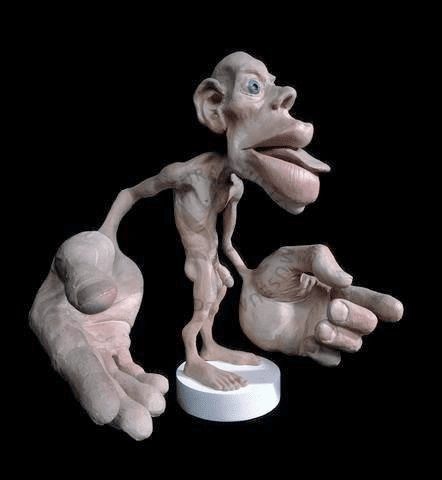
Fig. 8. Sensory Homunculus. This is all over the web with no obvious ownership.
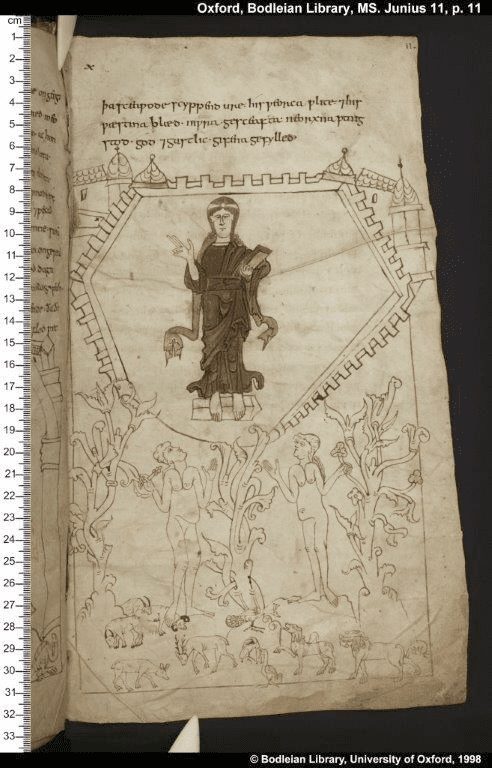
Fig. 9. Adam and Eve, Cædmon Manuscript, England, c. 1000. Bodleian Library, Oxford, MS Junius 11, p. 11 (© Oxford, Bodleian Library)
Anne Marie Rasmussen points out how often the genital badges are images of mobility: they walk, they ride, they fly, and some even crew ships. She connects them with comic stories about genitalia which leave their owners to wander the world: a penis attempts to hide in a nunnery, or a stray vagina is mistaken for a toad.[26] The sexual organ, that is, is detachable from the person and from gender: it is imagined as a force which wanders the world under its own steam. And the badges themselves, of course, are mobile, in that, pinned to people’s clothing, they moved around the world, their meanings no doubt shifting as they appeared in different material and social spaces. This means that they may well not be firmly gendered: we have no information at all about who wore them and when, but there is no reason to suppose that they had to be gender-appropriate to their wearers. If “female sexuality” is located in a badge of a vagina-pilgrim, then female sexuality is a quality which is mobile, detachable, not owned by female persons. A motif such as the phallus tree, shared by badges and other media, has a similar concept of sexuality as something which is out there in the world, only temporarily appropriated by individuals, something which one might pick off a tree.
Such images show coherent personhood and sexuality to be mutually exclusive, and desire as a disruptive force, a perception that is quite consistent with the Christian theorisation of the condition of post-lapsarian humanity. As St Augustine explained the effects of the Fall: “They experienced an unprecedented movement of their own disobedient flesh as punishment in kind, as it were, for their own disobedience. The soul, in fact, delighting now in its own freedom to do wickedness and scorning to serve God, was stripped of the former subjection of the body, and because it had wilfully deserted its own higher master, no longer kept its lower servant subject to its will.”[27] The experience of desire is an experience of splitting: body and soul, God and humanity, are recognised as distinct through the operation of desire. A human subject experiencing desire is registering its fallenness, its distance from its prelapsarian perfection, its non-self-identity. One does not have a sexuality because one is not one in these conditions, but a disordered collection of jostling entities. The prelapsarian Adam and Eve in the Anglo-Saxon Junius MS (fig. 9) anticipate this moment at which sexual awakening is registered at the cost of personal disintegration. They stand fully naked and barely distinguishable, with smooth groins, but their sexual parts are externalised to the genital-like forms of the plants that each grasps firmly. In the visual arts, this idea is not, however, limited to the theological or moral register, but is expressed also in popular and comic art and performance. Images of sexuality informed by such perspectives are likely to be uncomfortably placed in the category of “female sexuality,” both because this Augustinian model imagines female desire to be exactly analogous to male desire, and because sexuality is so disruptive of the subject that no-one can lay claim to one of their own. In such images and texts anything we might want to call “female sexuality” is already fraught, complicated and disrupted; there is no coherent package of desires, behaviours and relations that belongs to female subjects.
References
| ↑1 | Karma Lochrie, Heterosyncracies: Female Sexuality when Normal Wasn’t (Minneapolis: University of Minnesota Press, 2005), xv. |
|---|---|
| ↑2 | Hans Belting, An Anthropology of Images: Picture, Medium, Body, trans. Thomas Dunlap (Princeton: Princeton University Press, 2011), 37. https://doi.org/10.1515/9781400839780 |
| ↑3 | Ancrene Wisse: A Corrected Edition of the Text in Cambridge, Corpus Christi College, MS 402, ed. Bella Millett, Early English Text Society, Original Series 325 (Oxford: Oxford University Press, 2005), 121; Ruth Mazo Karras, Sexuality in Medieval Europe: Doing unto Others (New York: Routledge, 2005), 79; Christine de Pizan, The Book of the City of Ladies, trans. Rosalind Brown-Grant (Harmondsworth: Penguin, 1999), 144; Kathryn Gravdal, Ravishing Maidens: Writing Rape in Old French Literature and Law (Philadelphia: University of Pennsylvania Press, 1991), 111. https://doi.org/10.9783/9780812200331 |
| ↑4 | Lochrie, Heterosyncracies, xiv-xv. |
| ↑5 | The Book of Margery Kempe, ed. Barry Windeatt (Cambridge: D.S. Brewer, 2000), 332, 62, 196. |
| ↑6 | Jacqueline Murray, “Twice Marginal and Twice Invisible: Lesbians in the Middle Ages,” in Handbook of Medieval Sexuality, ed. Vern L. Bullough and James A. Brundage (New York: Garland, 2000), 191-222. |
| ↑7 | “Sex without sex” is the theme of a special issue of the Journal of the History of Sexuality 19, no. 1 (2010), ed. Sally N. Vaughn and Christina Christoforatou. |
| ↑8 | Þe Wohunge of ure Lauerd, ed. W. Meredith Thompson, EETS Original Series 241 (London: Oxford University Press, 1958), ll. 590-602; my translation. |
| ↑9 | Sara Lipton, “‘The Sweet Lean of his Head’: Writing about Looking at the Crucifix in the High Middle Ages,” Speculum 80, no. 4 (2005): 1172-1208. https://doi.org/10.1017/S003871340000138X |
| ↑10 | Jeffrey F. Hamburger, The Rothschild Canticles: Art and Mysticism in Flanders and the Rhineland circa 1300 (New Haven: Yale University Press, 1990), 3. |
| ↑11 | Sarah Bromberg, “Gendered and Ungendered Readings of the Rothschild Canticles,” Different Visions: A Journal of New Perspectives on Medieval Art 1 (2008), https://doi.org/10.61302/PMSR4045 |
| ↑12 | The concept of network here is indebted to Bruno Latour, Reassembling the Social: An Introduction to Actor-Network Theory (Oxford: Oxford University Press, 2007). |
| ↑13 | I have previously discussed the scripting of the meditation in Sarah Salih, “Transvestism in the Anchorhold,” in The Milieu and Context of the Wohunge Group, ed. Susannah M. Chewning (Cardiff: University of Wales Press, 2009), 148-64. |
| ↑14 | Michelle Sauer, “Uncovering Difference: Encoded Homoerotic Anxiety within the Christian Eremetic Tradition in Medieval England,” Journal of the History of Sexuality 19, no. 1 (2010), 133-52, at 143. https://doi.org/10.1353/sex.0.0075 |
| ↑15 | Madeline H. Caviness, “Patron or Matron? A Capetian Bride and a Vade Mecum for Her Marriage Bed,”Speculum 68, no. 2 (1993), 333-62, at 355. https://doi.org/10.2307/2864556 |
| ↑16 | Caviness, “Patron or Matron,” 356. |
| ↑17 | Paula Gerson, “Margins for Eros,” Romance Languages Annual 5 (1993): 47-53, at 50. |
| ↑18 | Gerson, “Margins for Eros,” 52. |
| ↑19 | Martha Easton, “‘Was it Good for You Too?’ Medieval Erotic Art and it Audiences,” Different Visions: A Journal of New Perspectives on Medieval Art 1 (2008), https://doi.org/10.61302/BUIO3522, 14; Sarah Salih, “Erotica,” in A Cultural History of Sexuality in the Middle Ages,ed. Ruth Evans(Oxford: Berg, 2010), 181-212, 186. https://doi.org/10.5040/9781350049673-ch-009 |
| ↑20 | Michael Camille, The Medieval Art of Love: Objects and Subjects of Desire (New York: Harry N. Abrams, 1998), 96. |
| ↑21 | A point previously made in Salih, “Erotica,” 189. |
| ↑22 | Anthony Weir and James Jerman, Images of Lust: Sexual Carvings on Medieval Churches (London: Routledge, 1999); Marian Bleeke, “Sheelas, Sex, and Significance in Romanesque Sculpture: The Kilpeck Corbel Series,” Studies in Iconography 26 (2005): 1-26; Eamonn Kelly, “Irish Sheela-na-gigs and Related Figures with Reference to the Collections of the National Museums of Ireland,” in Medieval Obscenities, ed. Nicola McDonald (Woodbridge: York Medieval Press, 2006), 124-37. |
| ↑23 | Paula Nuttall, “Reconsidering the Nude: Northern Tradition and Venetian Invention,” The Meanings of Nudity in Medieval Art, ed. Sherry C.M. Lindquist (Farnham, UK; Burlington, VT: Ashgate, 2012), 299-318. https://doi.org/10.4324/9781315085975-12 |
| ↑24 | Quoted in Keith Christiansen, “The View from Italy,” in From Van Eyck to Bruegel: Early Netherlandish Painting in the Metropolitan Museum of Art, ed. Maryan Wynn Ainsworth and Keith Christiansen (New York: Metropolitan Museum of Art, 1998), 39-62, 39. |
| ↑25 | Malcolm Jones, The Secret Middle Ages: Discovering the Real Medieval World (Stroud: Sutton, 2002), 256. |
| ↑26 | Anne Marie Rasmussen, Wandering Genitalia: Sexuality and the Body in German Culture between the Late Middle Ages and Early Modernity (London: King’s College London Medieval Studies, 2009), 8-9. |
| ↑27 | Augustine of Hippo, The City of God Against the Pagans, 7 vols, trans. George E. McCracken, Philip Levine, William M. Green, Loeb Classical Library (London: Heinemann; Cambridge Massachusetts: Harvard University Press, 1966), Book 13, ch. 13. |
